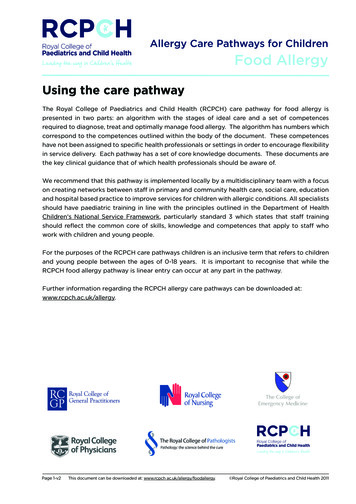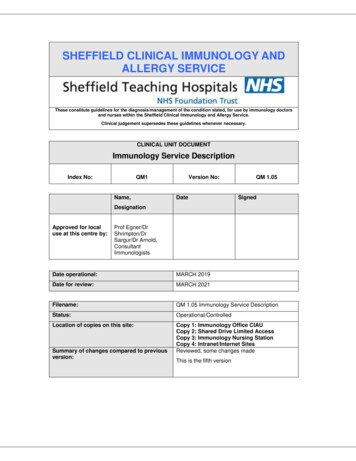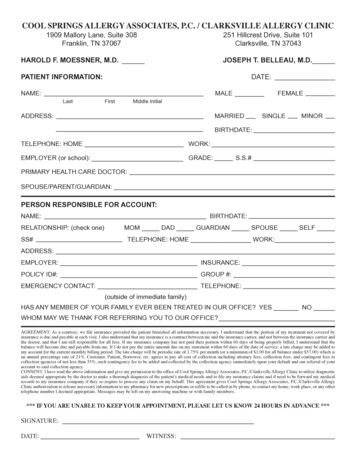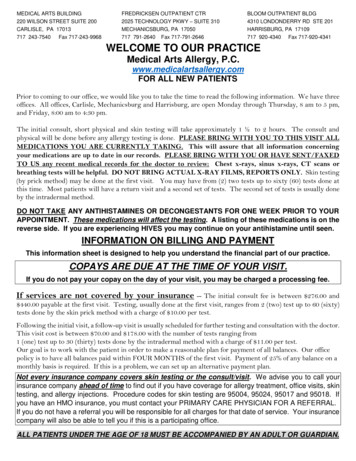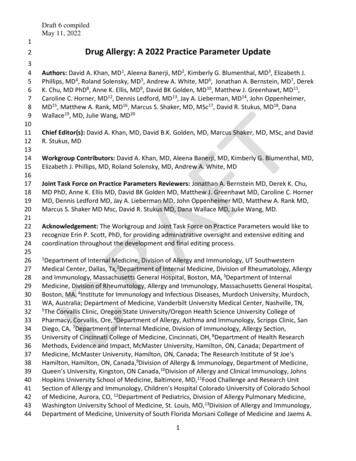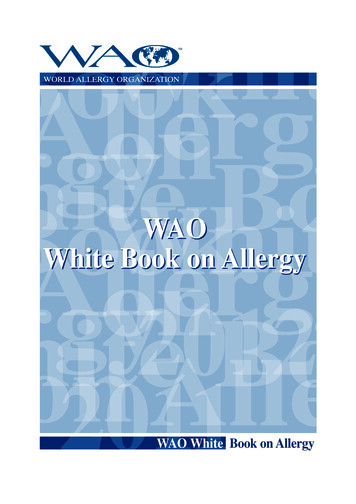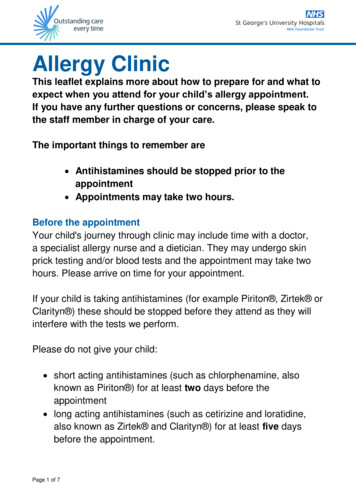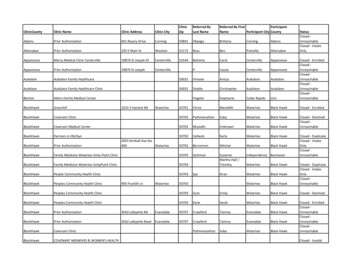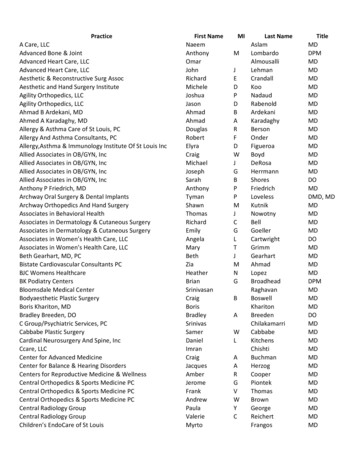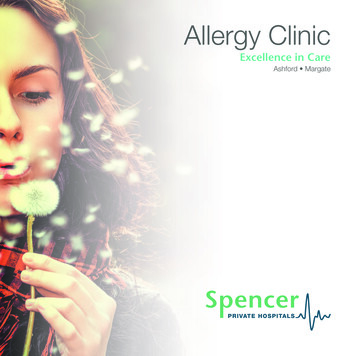
Transcription
Allergy ClinicExcellence in CareAshford Margate
ContentsWhat is an allergic reaction?1How to test for allergies2How are they treatedand can they be cured?4Why use a private allergy clinic?7Immunotherapy7Food allergy8Drug allergy9Venom allergy (bee and wasp)9Seasonal and perennialallergic rhinitus (hay fever)10Asthma10Uticaria (hives and nettle rash)11Anaphylaxis12References12
What is an allergic reaction?Your body has a system designed to protect it fromoutside harm, called your immune system. The immunesystem works by identifying harmful substances such asgerms, or poisons, and produces antibodies: specialistproteins that help white blood cells to ‘fight’ the harmfulsubstance. However, sometimes your body can mistakenlyidentify a harmless substance, such as pollen, as a threat.It produces antibodies to try to fight off the threat, and itis these antibodies that produce side effects. Dependingon the allergen, the side effects will differ. If the body isreleasing the antibody histamine, side effects will includesneezing, swollen eyes and a runny nose. For skin allergies,symptoms include redness and dryness, or a rash.it irritates those who are susceptible to it. Less commoncauses of allergic reaction include some prescriptiondrugs or painkillers. Some people are allergic to antibiotics,and do not find out until they take the medication.Symptoms and reactionsSymptoms of allergic reaction differ hugely. Some peopleonly ever experience very mild symptoms – for example,sneezing when the pollen count is very high. Anaphylacticshock is the most severe reaction to an allergy and is rapidin onset. If untreated it can cause death, so it is very importantthat those with allergic reactions seek medical guidancein case they are in danger of reacting this severely.Why does this happen?It is not clearly understood why the body reacts in thisway to certain harmless substances. There is a strongargument that genetics plays a part, as allergies often runin the family, and those born into families where parentssuffer from allergies are more likely to suffer themselves.Although only one in five children are likely to develop anallergy in the UK, this risk is doubled if one or both of theirparents suffer from an allergy themselves.Causes of allergic reactionAlthough it is possible to have an allergic reaction to almostany substance, there are a few common allergies thatmany people suffer from. Dust mites are a big cause ofallergic reaction. Dust mites live in house dust, often inbedding or soft furnishings, and it is their waste that the bodyreacts to. For this reason, it is advised to change pillowsand bedding regularly to prevent build-up of this allergen.Pollen is another very common allergen, so common in factthat we see pollen count recorded in many weather reports.As the temperatures rise, more pollen is found in the air,especially in less urban areas. Tree pollen is especiallyproblematic as it is high in the air, meaning that as it fallsThe hygiene hypothesis may also explain why allergiesare increasing at a higher rate now than ever previouslyrecorded. This hypothesis is the belief that the immunesystem needs to come into contact with a wide range ofsubstances whilst still in its infancy, but that due to modernhygiene practice, young children are no longer exposedto allergens. Infrequent exposure to micro-organismsmay lead to the immune system developing a tendencytowards allergy.There is also evidence to suggest that an allergy candevelop later in life as a result of stress on the body.This could be due to an unrelated illness or a majorlife event, for example bereavement.1
How to test for allergiesAllergy testing can be undertaken in many different ways,and it’s hard to know which method of testing will work bestfor you without knowing a little more about your options.Visiting your GP can be a useful start but they may notalways be able to help, and there are many other ways totest for allergies that may provide you with more information.The patient needs to avoid taking anti-histamines andcertain other medications before the test. Long actingantihistamines (those that do not cause drowsiness) shouldbe stopped for five days; short acting antihistamines canbe stopped 48 hours beforehand. Many cough mixturescontain an antihistamine; therefore please tell yourconsultant who is performing the test, any medicationthat you have taken.Skin prick testingSkin prick testing is the most common allergy test performedin an allergy clinic by specially trained staff. It is a simple,safe and quick test, providing results within 15-20 minutes.This will enable you to receive a diagnosis and managementplan at your appointment.The skin prick test introduces a tiny amount of allergeninto the skin, eliciting a small, localised allergic response,in the form of a wheal (bump) and flare (redness) at thesite of testing. These tests can be carried out on all agegroups, including babies.ü Skin prick testing is usually carried out on the innerforearm, but in some circumstances may be carriedout on another part of the body, such as the backor thigh. For example, there is a larger area on theback or thigh to perform testing on a baby, similarly,for those with troublesome eczema. The test can beperformed on any clear patch of skinü The test allergens are selected following a discussionwith your clinician and based on your historyü As few as 3 or 4 or up to about 25 allergens canbe testedü The skin is coded with a marker pen to identify theallergens to be testedü A drop of the allergen (extract) solution is placedon the skinü The skin is then pricked through the drop using thetip of a lancet – this can feel a little sharp but shouldnot be painful and should not bleed.2Intradermal testing (ID)ü Intradermal tests are used to investigate allergies tosome medications e.g. penicillin and venoms of beeand wasp. The test involves a small injection of oftendiluted medications or venoms into the dermis ofyour skin.ü ID is carried out on the inner forearmü The skin is coded with a marker pen to identify themedications/venoms to be testedü A drop amount of the medication/venom is injectedinto the skinü The results are ready within 15-20 minutesü In case of negative intradermal skin tests to medication,the consultant may suggest a challenge with aparticular medication to rule out a possibility of anallergic reaction.
Blood testsBlood tests measure the amount of Immunoglobulin E (IgE)antibody circulating in the blood. The test is carried out ona small sample of blood, usually taken from a vein in the armin the usual way. The sample is then sent to a laboratoryand the results are available in 7 to 14 days.These tests are particularly useful when skin pricktesting is impractical, for example, when the patient hasextensive eczema. They may also be used for someonewho cannot stop taking anti-histamine medications forany period of time, and so would not be suitable for a skinprick test. Blood tests can also be used to confirm skinprick test results. For example, before a food challenge test.There are a number of different blood tests for IgE available:Specific IgE (previously known as a RAST): thisü measures the amount of IgE to a specific food allergen,(a protein that can cause a reaction), such as a peanutor an egg. However, the test can give an elevatedresult without the patient having any symptoms(this is called “sensitisation”; it affects one-third ofthe population) and the elevated IgE is harmless.When an elevated result is seen in conjunction withsymptoms to that allergen, we can term the conditionan “allergy” and measures should be taken.Therefore, specific IgE testing should only berequested against an allergen against which thepatient has complained of symptoms and randomtesting is not recommended.Component resolved IgE testing: also known asü component resolved diagnosis (CRD) – this is a veryrecent development in specific IgE testing, wherebythe laboratory can detect IgE to specific pieces ofan allergen. Early evidence demonstrates that forsome food allergens, such as peanut, a positive CRDto a particular part of the peanut protein may bemore likely to indicate severe rather than mild allergy.Certain tests are therefore now available in specialistclinics using CRD methods.Challenge Testing (Provocation test)Like all medical tests, allergy tests have their drawbacksand are not perfect. Skin prick testing and blood testsare not always correct, so the only way to be certain thatan allergy is present is to give the patient the food ormedications in question under carefully controlledconditions. This is known as an allergy challenge.The challenge test is usually offered for one of three reasons:1. This test may be used after skin prick and bloodtests have suggested a food allergy but the resultsare inconclusive.2. This test may be offered when it is suspected thata person (often a child) has grown out of a particularfood allergy, as is often the case with childhoodallergies.3. Challenge testing is the main test to establish allergyto medications. Blood tests and skin tests are oftennot reliable in case of drug allergy and the only wayto rule out or confirm allergy to a particular drug is toreceive it again in graded doses under supervision.The medication can be administered orally e.g. penicillin,subcutaneously (small injections into soft tissues onyour upper arm) local anaesthetics, intravenously(into your vein), intramuscularly (into your muscleson your upper arm).3
Challenge tests are always undertaken in hospital underclose medical supervision where resuscitation equipmentand emergency medication are available in case a severereaction occurs. This is a precaution, but one that is takenvery seriously by staff involved.To check for a reaction, small amounts of the allergenare given to the patient at set times. Sometimes, a smallamount is first placed on the lips (this is called a lip dose).If no reaction is seen some of the allergen-containing foodis then eaten. Care is taken over the amount of allergeneaten, and the timings, so that any reactions can bemonitored carefully.Sometimes the food is disguised in a ‘double-blind’ trialso that neither the tester nor the patient knows whether itis the allergen or a placebo (a harmless substance) whichis being eaten. In this way, reactions caused by the ideaof eating a risky food, can be avoided.If at any time there is a reaction, the challenge will bediscontinued and appropriate avoidance advice will be given.How are they treated and canthey be cured?The science behind allergies is in some ways littleunderstood. It is true to say that allergies can be curedbut it’s not entirely clear to scientists how the processworks – and they can’t be cured in every case. However,there are plenty of treatments available and new discoveriesin allergy research are being made all the time. As withmany ailments, sometimes it is a case of trial and error tosee which treatment is best for an individual, and in somecases a combination of treatments will be used.Managing Your Allergy Involves Two Steps:1. Reducing the risk of an allergic reaction by avoidingthe allergen, wherever possible.2. Medical treatments to reduce symptoms includingmedications and immunotherapy.Avoiding allergens requires identifying the cause of yourallergy and then taking steps to reduce your exposureto the allergen. For instance, many people are allergic todust mites. Therefore, reducing dust mites in the housemay help to reduce symptoms.However, allergic reactions will still happen. Sometimes,this will be due to accidental consumption of the allergen(e.g. peanut). With many allergens, particularly those inthe air or environment, it is impossible to stop allergenexposure altogether. Hopefully, avoidance techniquescan improve symptoms, but medicines are often needed(especially with eczema, atopic asthma and hay fever)to provide symptom control.Nonetheless, in almost all cases, a combination of thesetwo approaches will result in significant improvement inallergic symptoms.4
Medication:AntihistamineMost people with mild allergies find that taking antihistaminetablets when exposed to allergens will help. These can betaken on a daily basis and help to reduce the symptomsof allergens, such as sneezing, a runny nose and red,swollen eyes. Antihistamine works by stopping thehistamine antibody from affecting the body’s cells in theway it normally would, thereby countering the symptoms.Although taking antihistamine regularly is a goodpreventative measure, it deals with the symptoms of theallergy rather than working to cure it.SteroidsFor more serious allergies, steroids are sometimesprescribed to tackle the symptoms. Although steroids areused to treat a variety of medical conditions, they are agood option for many allergy sufferers. This is becausesome steroids, called corticosteroids, are nearly identicalto cortisol. Cortisol is a natural hormone produced by theadrenal gland, and regulates immune response. Low dosesof steroids are very safe to use, however those usingsteroids regularly will need to have regular check-ups.EmollientsEmollient creams are generally used for skin conditions.In simple terms, they are creams which contain water andoil to keep the skin protected from allergens and lubricatedto lessen the symptoms of eczema. They also keep theskin clean and free from breakages caused by scratching,which then open up the skin to the possibility of infection.These creams can also sometimes contain a smallamount of steroid, known as topical steroid application.AdrenalineThe use of adrenaline (epinephrine) as an emergency allergytreatment is well understood by doctors, and it has savedmany lives. It is used to treat anaphylactic shock, wherethe sudden, high levels of histamine and other substancesreleased during an allergic reaction cause the patientto have difficulty breathing, and can also cause loss ofconsciousness.Anaphylactic shock can occur immediately after contactwith an allergen, or up to a few hours later. Adrenaline isa hormone produced by the body that decreases swellingassociated with an allergic reaction, relieves asthmasymptoms, eases breathing, tightens blood vessels andstimulates the heart.Research has shown that the sooner adrenaline is givenonce an anaphylactic reaction has started, the better thehealth outcome for the patient. This makes rapid treatmentof anaphylaxis possible, rather than having to wait forambulances carrying the medication to arrive.For this reason, people who are at risk of anaphylaxis areoften prescribed adrenaline auto injector devices (for example,Epipen, Jext or Anapen) for use by themselves or othersin an emergency. It is essential that these are always carriedwith the allergic individual and are available for use.Adrenaline auto-injectors look like pens and are prescribedaccording to the weight of the patient. Most children willbe given a junior injector, but larger children and teenagerswill be prescribed the adult version. Whichever style ortype of device is prescribed, the doctor prescribing itshould arrange training on using it. If the doctor does notoffer this, ask for it.5
Once a dose of adrenaline has been given, an ambulanceneeds to be called and the patient should go to hospitalso that any further reaction can be treated. It may be thatanother dose of adrenaline is needed before they can getto the hospital, and allergy sufferers who are at dangerof anaphylaxis often carry two injectors for this reason.By the time they reach hospital, the patient may have alate phase reaction, for which the hospital can providefurther treatment.AntibioticsThe symptoms of some allergic conditions can increasethe likelihood of localised infections. In particular, irritatedskin caused by eczema can be vulnerable to infection, ascan the nasal sinuses of people who suffer from hay feveror perennial rhinitis. For this reason it is important thatinfections are diagnosed and treated as soon as possible.Other MedicationCromoglicate works by blocking the responses of thecells that release the histamine during an allergic reaction,and can be a useful alternative to an anti-histamine inpreventing allergic reactions. However, this treatment onlyworks if taken before contact with the allergen, and it cantake a number of weeks for the effects of the treatment tobe seen. Cromoglycate is mostly used in eye drops, andis most beneficial in this treatment since anti-histaminesdo not always offer much relief from allergic eye symptoms.Anti-Leukotrienes Leukotrienes are chemicals releasedby the immune system that cause swelling and secretion,and can cause allergy symptoms to persist. Anti-leukotrienesreduce inflammation and mucus production and work ina similar way to steroids, but with fewer side effects.These drugs have often been used as add-on treatmentsalongside treatments for asthma and allergic rhinitis.However, they are now being used more often as a firstchoice in treating asthma, especially in children.Anti-IgE Drugs The IgE antibodies are the most commoncause of the immune system reacting to an allergen andinitiating an allergic response. New anti-IgE drugs arebeing developed, which aim to take the IgE antibodies out6of circulation. A number of studies have been conductedusing anti-IgE drugs as an add-on treatment for peoplewith severe allergic asthma. They showed that the anti-IgEmedication could allow some people to reduce, and evenstop, their inhaled steroid treatments. Anti-IgE drugs are nowlicensed for the treatment of severe asthma in adults andchildren over 12 in the UK, but there is still a lot of work tobe done to find their place in the treatment of allergic disease.Calcineurin Inhibitors Calcineurin inhibitors are a newtreatment, currently available as two creams – Tacrolimusand Pimecrolimus (also known as Protopic and Elidel)– for use on children over the age of two. They work byreducing the sensitivity of the immune system when theskin comes into contact with an allergen. In this way theyreduce inflammation, primarily in the case of atopic eczema,and can lessen itching and relieve rashes associated withallergic skin conditions.These creams are suitable for use on almost every part ofthe body, and are often used when steroids have provedunsuccessful, or are not suitable, for example, on sensitiveskin around the eyes. Emollients should continue to beused as well as these creams, but should not be appliedwithin two hours of applying the cream.Vaccinations should be avoided for a period before andafter, and during, the course of this treatment.A common side effect of these creams is a burningsensation on application, which generally settles downafter a few days. These drugs are thought to be safe andextremely effective in the short-term, but their safety withlong-term use has yet to be proven.
ImmunotherapyWhy use a private allergy clinic?Immunotherapy is a type of treatment for allergies that worksby suppressing a specific immune response. It is a way ofchanging the body’s immune system to help it to recogniseharmless substances and learn not to respond negativelyto them. This is known more specifically as suppressionimmunotherapy, and is the only available treatment forallergies that deals with the allergy itself rather than treatingthe symptoms, such as antihistamine or steroids.It is estimated that one in four people will suffer with allergiesat some point in their lives, and allergic reactions continueto be a growing problem with ever more severe side-effects.For such a common and yet potentially life-threateningcondition, it is not surprising that there are a number ofclinics dedicated to dealing with treatment and allergiesto all kinds of substances, including drugs, pollen anddust. Allergies are notoriously difficult to diagnose and themore specialist knowledge available the better a patient’schances are of getting a fast and accurate diagnosis.There are countless treatment options for those sufferingwith allergies, and talking to a professional in the field ofallergy science can help to decide which of the treatmentsavailable would be best for an individual. The advantagesof a private allergy clinic are outlined below.Immunotherapy works by exposing the body to the allergena miniscule amount at a time, allowing the body to slowlyadjust and become less sensitive to it. This process isknown as desensitisation. The treatment is administeredby a course of injections, tablets or drops under the tongueover a period of one to three years by a doctor or allergistand is normally only used in very serious cases, especiallyif the patient is at risk of anaphylactic shock, or if they findit hard to live a normal life due to their allergies. It is notusually recommended for food allergies, although recentlyclinical trials have begun to try and develop immunotherapyfor food allergies.Another method of immunotherapy for allergies is known as‘rush’ immunotherapy. This is normally delivered in hospital,as it involves a more rapid administration of the allergen overa shorter period of time. This is often appropriate for beeor wasp sting allergies, as speeding up the process meansthat the patient will be safer from another sting more quickly.This method can be just as effective as the slower methodbut due to the associated risks, care must be taken.Patients considered for immunotherapy are normally thosewhose allergies are life-threatening. Immunotherapy doesnot work for everyone, and in some people will only improvesymptoms rather than cure the allergy completely. It is mosteffective when started as early as possible, in childrenor as soon as the allergy has been diagnosed.ExpertisePrivate allergy clinics specialise in dealing purely with allergies.The consultants will be knowledgeable about all typesof allergy. They will have details of the latest treatmentoptions, have a good understanding of allergies in adultsand children of all ages and will have detailed informationabout living with allergies and improving quality of life atthe same time. They will have access to rapid testing andwill often be able to provide you with test results on site.7
ExperienceFood allergyDue to the number of allergies that a clinic will encounter,a practitioner will have had a vast amount of experiencewith allergies and will be good at spotting things that aGP may not be able to clearly recognise. Using a privateallergy clinic provides you with peace of mind that yourpractitioner will see patients with allergies on a dailybasis, and their specialist knowledge will assist them indiagnosing and treating your allergies.Treatment for an allergy is not always straightforward.Different treatments will work for different people,which is why a private allergy clinic will usually provide apersonalised treatment plan to ensure that the patient’sspecific needs are addressed. Sometimes, a few treatmentswill need to be tried before one can be established assuccessful at dealing with the allergy.There are many different kinds of food allergies – in fact;it is possible to be allergic to almost any kind of food.A food allergy is caused by your body mistakenly identifyinga certain kind of food as a threat. One food allergy in particularthat is very common is peanut allergy, but allergies to soya,eggs, milk and wheat are also prevalent. It can be hard torecognise whether you are suffering from food intoleranceor from an allergy, because the symptoms can be similar.Food intolerance can occur when the body fails to producea sufficient quantity of a particular enzyme needed to breakdown a food and aid digestion. For example if a personsuffers wind and bloating every time they consume milk ormilk products they may be suffering from lactose intolerance,a condition caused by lack of the lactose-digestingenzyme lactase. Allergy tends to be more serious and willusually respond to taking antihistamine, whereas foodintolerance will not.A holistic approachSymptoms of a food allergyOften, allergies can be caused by more than just a physicalreaction to a substance. A private clinic will often look atthe whole picture, taking into account changes in lifestyleor major life events.Symptoms of a food allergy will differ greatly dependingon the severity of the allergy. If the allergy is mild, you maynotice a slight burning or itching sensation in your throatwhen eating certain foods. It is possible to have a histaminereaction from a food allergy, which can include a runnynose, sore or itchy eyes, and a rash on the skin. A moreserious allergy can lead to anaphylactic shock, where thethroat can close up and make it very difficult to breathe.A shot of adrenaline e.g. Epipen will be administered inthese cases to counteract the effects.Personalised treatment plansExcellent serviceThe main benefit of visiting a private clinic is the excellentservice provided by the facility as a whole. Private clinics areknown for their dedication to the patient, their cleanliness,their facilities and their professional staff. The staff willhave time to discuss your symptoms in detail beforedeciding the tests that would be most appropriate.8
Treatments for food allergiesIt can be hard to regularly treat a food allergy. Taking anantihistamine when you notice a reaction will help, as willavoiding eating certain types of foods and keeping an eyeon food labels to check that food hasn’t been in contactwith allergens.Drug allergyDrug allergies, like any other allergies, are caused by thebody mistakenly recognising the drug taken as a threat tothe immune system and producing antibodies to try to ridthe body of the perceived threat. Common drug allergiesinclude penicillin, other antibiotics, painkillers. It can behard to diagnose a drug allergy, as you may not take thedrug often. When you take a drug you have never takenbefore it is a good idea to keep an eye on your body tomake sure you do not have an adverse reaction.is reached and the body can tolerate it. Allergy to medicationsmay resolve over years so it’s worth undergoing a challengetest with a particular drug to see whether you are still allergic.Some patients mistake side effects of the medications foran allergic reaction which limits the treatment options or theco-existing infection can be responsible for the symptoms,not necessary the medication e.g. 90% of patients whoreport allergy to penicillin are not actually allergic to them.Venom allergy (bee and wasp)Bee sting venom is an irritant, causing swelling and painaround the affected area in not just those with a venomallergy but anyone who is stung by a bee or wasp.However, the body can overreact to a sting, producingantibodies that have an adverse reaction to the immunesystem and the whole body. If you have reacted to a beeor wasp sting before, it is highly likely that you will reactadversely if you are stung again.Symptoms of drug allergySymptoms of a drug allergy are normally a little differentto other allergies. Whilst many allergic reactions will displaythemselves through a skin rash or the development of hives,itching, breathing problems or swelling, drug allergies areoften also accompanied by vomiting and feeling dizzy orlight headed. Keeping a diary of symptoms can be helpfulif you suspect you may be allergic to a certain drug. It isimportant to keep your doctor informed of any suspectedallergies to drugs, as they can be very serious. Like allallergies, they may worsen over time.Treatments for drug allergiesOften there is no obvious treatment available for a drugallergy except to stop using the drug and try an alternative.Your doctor will be able to advise you on this. There arenormally plenty of alternative medications available soit isn’t always a problem. There are very few treatmentprogrammes for drug allergies for this reason. However,in cases where the medication is essential, a desensitisationprogramme can be used. This involves a very slow,gradual introduction to the drug until the desired levelSymptoms of venom allergiesBee and wasp stings will affect anyone who is stung as theyare irritants. However, if you are allergic to bee or wasp stingvenom the reaction will be more pronounced and severe.A mild reaction is normally identified by pain at the stingsite, a welt or mark where the sting entered the body,and a small area of swelling that disappears in a coupleof days. A moderate reaction may include more seriousswelling and a rash that spreads to other parts of the body9
other than the affected area. If the swelling is pronouncedfor longer than a day or two it is likely that you have sufferedfrom a moderate allergic reaction. A severe allergic reactioncan result in anaphylactic shock. If you are a parent,you will be pleased to know that children are of a lesserrisk of anaphylaxis than adults are, but if your child hasa moderate reaction to a bee or wasp sting it is alwaysadvised to see a doctor to make sure that it is not serious.Anaphylaxis is life threatening as it can block the airwaysand so it is essential that if you suspect someone may besuffering with it you seek medical help immediately.Treatments for venom allergiesFor minor reactions, it is best to try and remove the stingas soon as possible. Only bee stings leave a stinger inthe skin – wasp stings do not. Applying a cold compresscan then help reduce swelling. For moderate or moreserious reactions, contact your doctor for advice. You maybenefit from having adrenaline pen and be referred forimmunotherapy which is often a lifesaving treatment.Seasonal and perennial allergicrhinitis (hay fever)Hay fever is caused by the body producing an inappropriateimmune response to pollen, producing antibodies whichtry to ‘fight’ the pollen and result in unpleasant side effectssuch as a runny nose, dry and itchy eyes, sneezing andcoughing, and skin irritation. It is prevalent during thesummer months and in dry weather, where there is morepollen in the air. Often, tree pollen is the culprit as it wil
tests have suggested a food allergy but the results are inconclusive. 2. This test may be offered when it is suspected that a person (often a child) has grown out of a particular food allergy, as is often the case with childhood allergies. 3. Challenge testing is the main test to establish allergy to medications. Blood tests and skin tests are .
